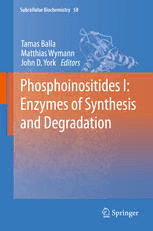
Phosphoinositides I: Enzymes of Synthesis and Degradation PDF
Preview Phosphoinositides I: Enzymes of Synthesis and Degradation
Phosphoinositides I: Enzymes of Synthesis and Degradation SUBCELLULARBIOCHEMISTRY SERIESEDITOR J.ROBINHARRIS,UniversityofMainz,Mainz,Germany ASSISTANTEDITOR P.J.QUINN,King’sCollegeLondon,London,U.K. RecentVolumesinthisSeries Volume33 BacterialInvasionintoEukaryoticCells TobiasA.OelschlaegerandJorgHacker Volume34 FusionofBiologicalMembranesandRelatedProblems EditedbyHerwigHildersonandStefanFuller Volume35 Enzyme-CatalyzedElectronandRadicalTransfer AndreasHolzenburgandNigelS.Scrutton Volume36 PhospholipidMetabolisminApoptosis EditedbyPeterJ.QuinnandValerianE.Kagan Volume37 MembraneDynamicsandDomains EditedbyP.J.Quinn Volume38 Alzheimer’sDisease:CellularandMolecularAspectsofAmyloidbeta EditedbyR.HarrisandF.Fahrenholz Volume39 BiologyofInositolsandPhosphoinositides EditedbyA.LahiriMajumderandB.B.Biswas Volume40 ReviewsandProtocolsinDT40Research EditedbyJean-MarieBuersteddeandShunichiTakeda Volume41 ChromatinandDisease EditedbyTapasK.KunduandDipakDasgupta Volume42 InflammationinthePathogenesisofChronicDiseases EditedbyRandallE.Harris Volume43 SubcellularProteomics EditedbyEricBertrandandMichelFaupel Volume44 PeroxiredoxinSystems EditedbyLeopoldFlohdJ.RobinHarris Volume45 CalciumSignallingandDisease EditedbyErnestoCarafoliandMarisaBrini Volume46 CreatineandCreatineKinaseinHealthandDisease EditedbyGajjaS.SalomonsandMarkusWyss Volume47 MolecularMechanismsofParasiteInvasion EditedbyBarbaraA.BurleighandDominiqueSoldati-Favre Volume48 TheCoroninFamilyofProteins EditedbyChristophS.Clemen,LudwigEichingerandVasilyRybakin Volume49 LipidsinHealthandDisease EditedbyPeterJ.QuinnandXiaoyuanWang Volume50 GenomeStabilityandHumanDiseases EditedbyHeinzPeterNasheuer Volume51 CholesterolBindingandCholesterolTransportProteins EditedbyJ.RobinHarris Volume52 AHandbookofTranscriptionFactors EditedbyT.R.Hughes Forfurthervolumes: http://www.springer.com/series/6515 Tamas Balla (cid:129) Matthias Wymann (cid:129) John D.York Editors Phosphoinositides I: Enzymes of Synthesis and Degradation 2123 Editors Dr.TamasBalla Dr.JohnD.York NationalInstitutesofHealth DukeUniversityMedicalCenter NICHD PharmacologyandCancer Bethesda,MD Biology USA Durham,NC USA Dr.MatthiasWymann UniversityofBasel Cancer-andImmunobiology Basel,Switzerland ISBN978-94-007-3011-3 e-ISBN978-94-007-3012-0 DOI10.1007/978-94-007-3012-0 SpringerDordrechtHeidelbergLondonNewYork LibraryofCongressControlNumber:2012931684 © SpringerScience+BusinessMediaB.V.2012 Nopartofthisworkmaybereproduced,storedinaretrievalsystem,ortransmittedinanyformorby anymeans,electronic,mechanical,photocopying,microfilming,recordingorotherwise,withoutwritten permissionfromthePublisher,withtheexceptionofanymaterialsuppliedspecificallyforthepurposeof beingenteredandexecutedonacomputersystem,forexclusiveusebythepurchaserofthework. Printedonacid-freepaper SpringerispartofSpringerScience+BusinessMedia(www.springer.com) Preface WhenIwasapproachedtoshapeabookaboutphosphoinositidesignaling,Ifirstfelt honoredandhumbled. Onsecondthought, thisappearedtobeanimpossibletask. Phosphoinositideshavegrownfrombeingjustacuriouslipidfractionisolatedfrom bovinebrain,showingincreasedradioactivemetaboliclabelingduringintensestimu- lationprotocols,tobecomethefocusofimmenseinterestaskeyregulatorymolecules thatpenetrateeveryaspectofeukaryoticbiology.Theexpansionofthisfieldinthe last three decades has been enormous: it turned from a basic science exercise of a devotedfewtohighlytranslatablesciencerelevanttoalargenumberofhumandis- eases(isn’tthisthenatureofgoodbasicscience?).Theseincludecancer,metabolic-, immuno-andneurodegenerativedisorders,tonamejustafew.Reviewingthelarge numberofenzymesthatconvertphosphoinositideswouldfillabook—letalonethe diverse biological processes in which phosphoinositides play key regulatory roles. Giventheinterest, acollectionofup-to-datereviewscompiledinabookisclearly warranted,whichwasenoughtoswaymetoacceptthisassignment.Asoneeditor isunabletohandlethisenormoustask,IwasdelightedwhenMatthiasWymannand JohnYorkwerekindenoughtojoinmeinthisambitiouseffort. When thinking about potential authors, the obvious choice would have been to approachthepeoplewhosecontributionshavebeencrucialtopushandelevatethis fieldtothelevelitistoday.BobMichell,propheticallyplacedphosphoinositidesin thecenterofsignaltransductionina1975Biochem.Biophys.Actareview(Michell 1975),MichaelBerridgehadakeyroleinlinkingphosphoinositidesandCa2+ sig- nalingandwhosefascinatingreviewshaveinspiredmanyofus(BerridgeandIrvine 1984). RobinIrvine, whosegroupfoundthatInsP wasamixtureoftwoisomers, 3 theactiveIns(1,4,5)P andaninactiveIns(1,3,4)P , andwhodescribedthetetrak- 3 3 isphosphatepathway(Irvineetal.1986),andwhoalwayschallengesuswithmost provocativeideas. PhilipMajerus, whohasinsistedontheimportanceofinositide phosphatases(Majerusetal.1999)veryearlyon.ThegroupofLewisCantley,with the discovery of PI 3-kinase activities and the mapping of downstream effectors (Whitman et al. 1988; Franke et al. 1997), or theWaterfield lab where the first PI 3-kinase catalytic subunit was isolated and cloned (Otsu et al. 1991; Hiles et al. 1992). Peter Downes, who recognized the translational value of phosphoinositide research.JeremyThornerandScottEmr,whoseworkinbaker’syeaststillformsthe v vi Preface foundation of our understanding of the role of inositol lipids in trafficking (Strahl andThorner2007)orPietroDeCamilli,whosegroupdocumentedthecentralroleof inositidesinbrainandsynapticbiology(Cremonaetal.1999).Therearemanyothers whomadevaluableorevengreatercontributionstophosphoinositideresearch.The abovelistreflectsmybias,astheseresearchershadthelargestimpactonmythinking andthedirectionsofmywork.Researchis,however,aconstantlyevolvingprocess and we (now Matthias and John being involved) wanted to involve contributions ofscientistswhorepresentasecondorthirdwaveofresearchersinfectedwiththe interest in phosphoinositides. We made an effort to recruit authors who have been traineesofthesefoundinglaboratories.Withthisselectionourgoalwastosample the view of the current and future generation. By selecting their trainees, we feel thatwepaytributetothe“FoundingFathers”, andshowthattheresearchtheyput inmotionisaliveandcontinueswithfreshideas,newambitionsandatranslational andtherapeuticvalue. Phosphoinositideresearchinthe1980swenthandinhandwithresearchonCa2+ signalingpursuedin“non-excitable”cellsandwasalsomarkedwiththediscoveryof thefamilyofproteinkinaseCenzymes,regulatedbydiacylglycerol,oneoftheprod- uctsofphosphoinositide-specificphospholipaseCenzymes.Theseareasofresearch developedandexpandedtoformtheirownfields,andcouldnotbediscussedherein detail—eventhoughtheyarelinkedhistoricallytothedevelopmentofphosphoinosi- tidesignaling.TheenormousworkofthegroupsofYasutomiNishizukaonprotein kinaseC,andKatsuhikoMikoshibaoncloningandcharacterizingtheIns(1,4,5)P 3 receptorsareprimeexamplesoftheseachievements.Althoughwecouldnotcover alltheseareas,weincludedachapteronCa2+ signalingviatheIns(1,4,5)P recep- 3 torbyColinTaylor, atraineeoftheMichaelBerridge’slab, whereimportantlinks betweenCa2+releaseandIns(1,4,5)P receptorsignalingwerediscovered.Wealso 3 decided to allocate some space to inositol phosphates, the soluble counterparts of someofthephosphoinositides.Thesemoleculesforlonghadbeenviewedonlyas the metabolic products of the second messenger Ins(1,4,5)P but recently gained 3 significantprominenceasregulatorsofimportantphysiologicalprocesses.Withthe discovery of the highly phosphorylated and pyrophosphorylated inositols and the enzymesthatproducethem,itbecameclearthatthissystemrepresentsawholenew regulatoryparadigmwithexcitingnewdevelopments. Finally, it was a difficult dilemma whether to include a Chapter on the early historyofphosphoinositides.Wedecidedagainstitforanumberofreasons. First, thereallyinterestinghistoryistracedbacktostudiesthatprecededthelandmark1975 BobMichellreviewandincludedtheworkoftheHokins(1987),BernardAgranoff (2009)andotherpioneersofphosphoinositideresearch.Nobodycouldtelltheseearly developmentsbetterthanBobMichellinhisseveralrecollections(Michell1995)or RobinIrvinewhocommemoratedthe20yearsofIns(1,4,5)P andtheperiodleading 3 toitsdiscovery(Irvine2003).Weencouragetheyoungreaderstogobackandread these recollections, as they show several examples of how seemingly uninspiring observations formed the beginning of something that became huge as it unfolded. What came after these landmark discoveries is so overwhelming that each one of us has own views and subjective memories and stories to tell on some aspects of Preface vii it. As Editors we felt that our views should not be elevated above others on these historicalaspects,andleaveittotheauthorsoftheindividualChapterstoelucidate the diversity in this respect. The only exception is a Chapter on the history of PI 3-kinases byAlexToker that we felt deserves special emphasis as it had the most transformingimpactonthefieldsincethelate1980s. Oneneedstounderstandthatselectionofauthorsisasubjectiveprocessanddoes notalwaysreflectonwhocontributedthemostinaselectedfield.However,weare confident that proper credit is given in the individual Chapters to each groups and individualswhoseworkhasmovedthisfieldforward.Itshouldalsobeunderstood that a field that generates over 10,000 entries in PubMed with each keyword that relates to phosphoinositides cannot be covered without missing some aspects that couldbeimportant. However, wetrustthatthiscollectionwillbefoundusefulfor boththeexpertsandthenovices. References AgranoffBW(2009)Turtlesalltheway:Reflectionsonmyo-Inositol.JBiolChem284(32):21121– 21126 BerridgeMJ,IrvineRF(1984)Inositoltrisphosphate,anovelsecondmessengerincellularsignal transduction.Nature312:315–321 CremonaO,etal(1999)Essentialroleofphosphoinositidemetabolisminsynapticvesiclerecycling. Cell99:179–188 FrankeTF,KaplanDR,CantleyLC,TokerA(1997)DirectregulationoftheAktprotooncogene productbyPI3,4P2.Science275:665–668 HilesIDetal(1992)Phosphatidylinositol3-kinase:structureandexpressionofthe110kDacatalytic subunit.Cell70:419–429 HokinLE(1987)Theroadtothephosphoinositide-generatedsecondmessengers.TrendsPharmacol Sci8:53–56 IrvineRF(2003)20yearsofIns(1,4,5)P3,and40yearsbefore.NatRevMolCellBiol4(7):586–590 IrvineRF,LetcherAJ,HeslopJP,BerridgeMJ(1986)Theinositoltris/tetrakisphosphatepathway— demonstrationofinositol(1,4,5)trisphosphate-3-kinaseactivityinmammaliantissues.Nature 320:631–634 Majerus PW, Kisseleva MV, Norris FA (1999) The role of phosphatases in inositol signaling reactions.J.BiolChem274:10669–10672 MichellB(1995)Earlystepsalongtheroadtoinositol-lipid-basedsignalling.TrendsBiochemSci 20(8):326–329 MichellRH(1975)Inositolphospholipidsandcellsurfacereceptorfunction.BiochimBiophysActa 415:81–147 OtsuMetal(1991)Characterizationoftwo85kDaproteinsthatassociatewithreceptortyrosine kinases,middle-T/pp60c-srccomplexes,andPI3-kinase.Cell65:91–104 StrahlT,ThornerJ(2007)Synthesisandfunctionofmembranephosphoinositidesinbuddingyeast, Saccharomycescerevisiae.BiochimBiophysActa1771(3):353–404 WhitmanM,DownesCP,KeelerM,KellerT,CantleyL(1988)Type-Iphosphatidylinositolkinase makesanovelinositolphospholipid,phosphatidylinositol-3-phosphate.Nature332:644–646 Contents 1 ThePhosphatidylinositol4-Kinases:Don’tCallitaComeback ...... 1 ShaneMinogueandMarkG.Waugh 2 PIPKinasesfromtheCellMembranetotheNucleus............... 25 MarkSchramp,AndrewHedman,WeiminLi,XiaojunTan andRichardAnderson 3 ThePhospholipaseCIsozymesandTheirRegulation............... 61 AurelieGresset,JohnSondekandT.KendallHarden 4 Phosphoinositide3-Kinases—AHistoricalPerspective.............. 95 AlexToker 5 PI3Ks—DrugTargetsinInflammationandCancer ................ 111 MatthiasWymann 6 Phosphoinositide3-KinasesinHealthandDisease ................. 183 AlessandraGhigo,FulvioMorello,AlessiaPerinoandEmilioHirsch 7 PhosphoinositidePhosphatases:JustasImportantastheKinases ... 215 JenniferM.Dyson,ClareG.Fedele,ElizabethM.Davies, JelenaBecanovicandChristinaA.Mitchell 8 ThePTENandMyotubularinPhosphoinositide3-Phosphatases: LinkingLipidSignallingtoHumanDisease ....................... 281 ElizabethM.Davies,DavidA.Sheffield,PriyankaTibarewal, ClareG.Fedele,ChristinaA.MitchellandNicholasR.Leslie Erratum.......................................................... E1 Glossary ......................................................... 337 Index ............................................................ 343 ix Abbreviations AD Alzheimer’sdisease AMPK 5(cid:2)-AMP-activatedproteinkinase ALL Acutelymphocyticleukemia ALS Amyotrophiclateralsclerosis AML Acutemyeloblasticleukemia ARNO Arfnucleotidebindingsiteopener ASK1 Apoptosissignal-regulatingkinase1 ATM Ataxiatelangiectasiamutated ATX Arabidopsistrithorax1 Bad Bcl-XL/Bcl-2-associateddeathpromoter BAFF BcellactivationfactoroftheTNFfamily BCR Bcellreceptor Bcr/Abl Breakpointclusterregion/Abelsonkinasefusionprotein Btk Bruton’styrosinekinase c-Kit Stemcellgrowthfactorreceptor CAD CaspaseactivatedDNase CCR(L) C-Cchemokinereceptor(ligand)type CDK Cyclin-dependentkinase CDKN2A Cyclin-dependentkinaseinhibitor2A CERT Ceramidetransferprotein CIN85 Cbl-interactin protein of 85kD (also Ruk (regulator of ubiqui- tous kinase), SETA (SH3 domain-containing gene expressed in tumorigenicastrocytes)) CML Chronicmyeloidleukemia CMT Charcot-Marie-Tooth COPI/II CoatomerproteincomplexI/II CXCR(L) C-X-Cchemokinereceptor(ligand)type DAAX Deathdomain-associatedprotein DAG Diacylglycerol DGK Diacylglycerolkinase DH Dbl-homology DMSO Dimethylsulfoxide xi
